We have been growing our own potatoes at home for quite a few years now, and it’s something both myself and the kids look forward to each season. We have even used potatoes for a home education unit study, which I will share on the blog very soon, and the kids had a blast with all the activities, from planting experiments to cooking our homegrown spuds.
I am going to let you into a secret though; the first year I grew my own potatoes I was concerned about eating them. You see they looked so white compared to the shop bought ones. I am so glad I did start growing my own potatoes though as they are the easiest crop to grow and there are so many varieties to try you will never get bored of the potato.
There’s nothing better than digging up fresh potatoes and having them on your plate within 30 minutes! One of our favourite ways to enjoy homegrown potatoes is in a hearty Irish stew, a simple, budget-friendly meal that makes the most of a good potato harvest.
In this blog post, I’ll share our step-by-step guide to growing potatoes, including how to chit potatoes for the best start, the difference between first earlies, second earlies, and main crop varieties, and the best potatoes for growing your own Christmas spuds. Plus, I’ll include our family’s favourite Irish stew recipe so you can turn your harvest into a delicious, warming meal.
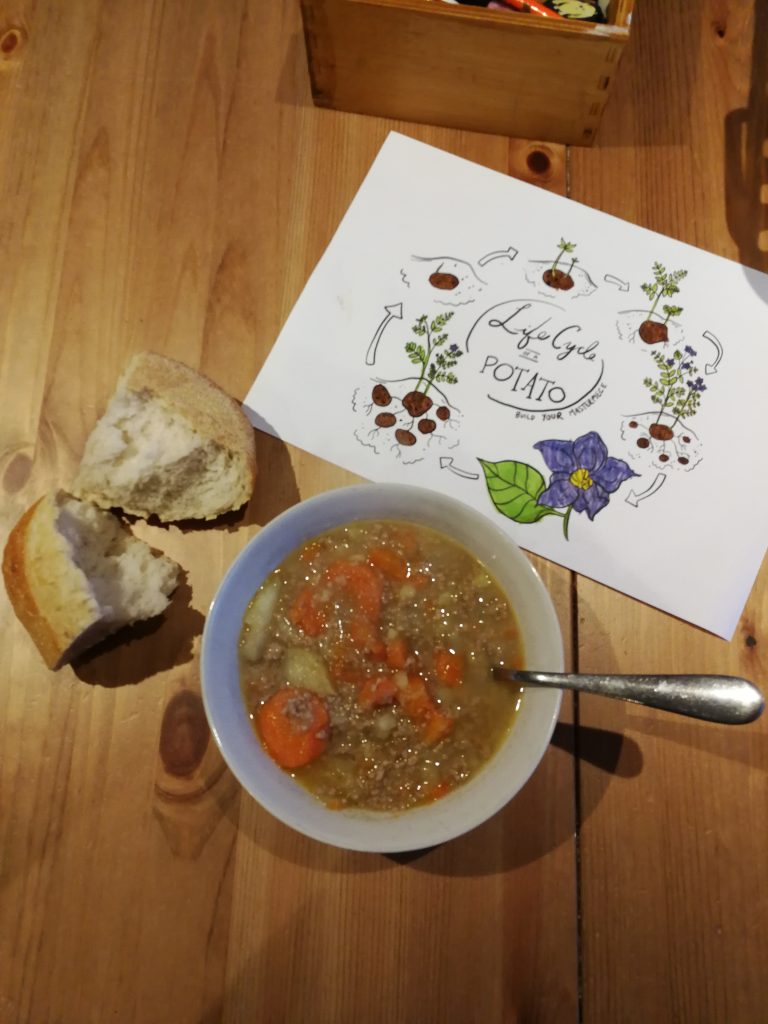
Overview of Our Potato Growing Process
We begin chitting our seed potatoes in late January or early February, giving them a head start before planting. Our goal is to have our first earlies in the ground by St Patrick’s Day (17th March)—a tradition that has worked well for us over the years. We earth up our potatoes gradually over the next few months every time the shoots reach about 10cm until the raised bed or container is full. I love being able to harvest our first potatoes by the Summer Solstice in June, making them a perfect addition to our midsummer meals.
Some seasons, we also grow second earlies and main crop potatoes, meaning we’re still harvesting homegrown potatoes right up until late September or early October. We buy our seed potatoes locally from Patch Potatoes, choosing varieties that thrive in our zone 9b garden and allotment.
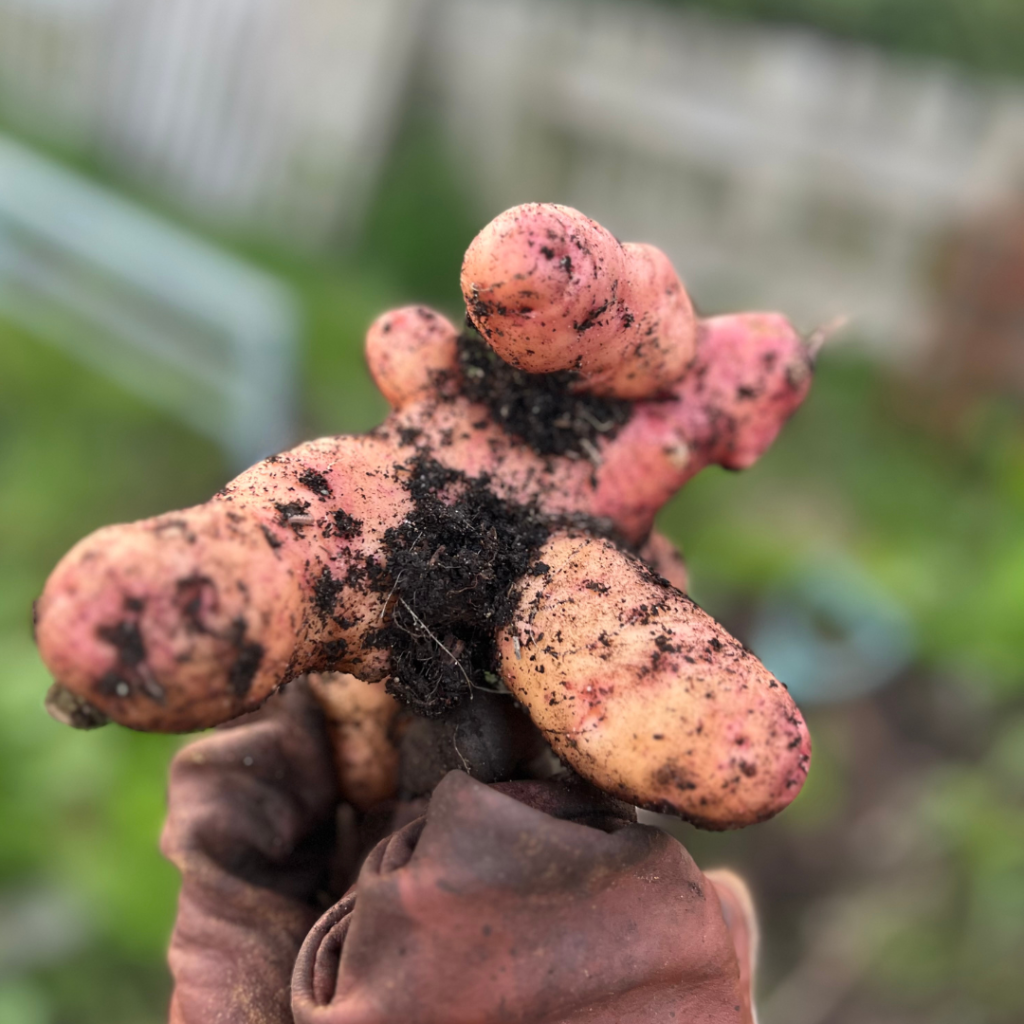
Potato Growing Glossary: Key Terms Explained
Seed Potato – A specially grown potato used for planting, not for eating. It sprouts and grows into a new potato plant.
Chitting – The process of sprouting seed potatoes indoors before planting to give them a head start.
Earthing Up – Mounding soil around potato plants as they grow to protect tubers from sunlight and encourage a bigger harvest.
First Earlies – Potatoes that grow quickly and are harvested early in summer (e.g., new potatoes).
Second Earlies – A type of potato planted slightly later than first earlies but still harvested in summer, before main crops.
Main Crop Potatoes – Potatoes that take the longest to grow and are harvested in late summer or autumn. They store well for winter use.
Blight – A common fungal disease that affects potatoes, causing leaves to rot and tubers to spoil.
Tubers – The part of the potato plant that grows underground and is harvested as food.
How to Grow Potatoes: A Step-by-Step Guide
In this guide, I’ll walk you through everything you need to know about growing potatoes—from chitting, to sowing, to earthing up, to harvesting. Whether you’re a first-time grower or looking to refine your technique, this step-by-step approach will help you get the best out of your potato crop. You’ll find everything from choosing the right variety to planting, caring for, and harvesting your potatoes. Here’s what you’ll learn:
- Chitting Potatoes: How to start your potatoes early for a head start.
- Earthing Up: How to keep adding soil to your plants to ensure they don’t get spoiled by being exposed to the sun.
- First Earlies, Second Earlies, and Main Crops: The best types for your garden and how to grow them.
- Christmas Potatoes: I am going to outline my plan for my 2025 Christmas Potatoes
- Potato Variety Summary Table: A summary to help you choose which type of potatoes suit you best
- Potatoes in Irish History: Their rich connection to Irish culture.
- Nutritional Benefits: Why potatoes are a great addition to your diet.
- Hearty Recipes: Enjoy your harvest with a delicious Irish stew and other potato dishes.
Ready to dive in? Let’s start with chitting potatoes.
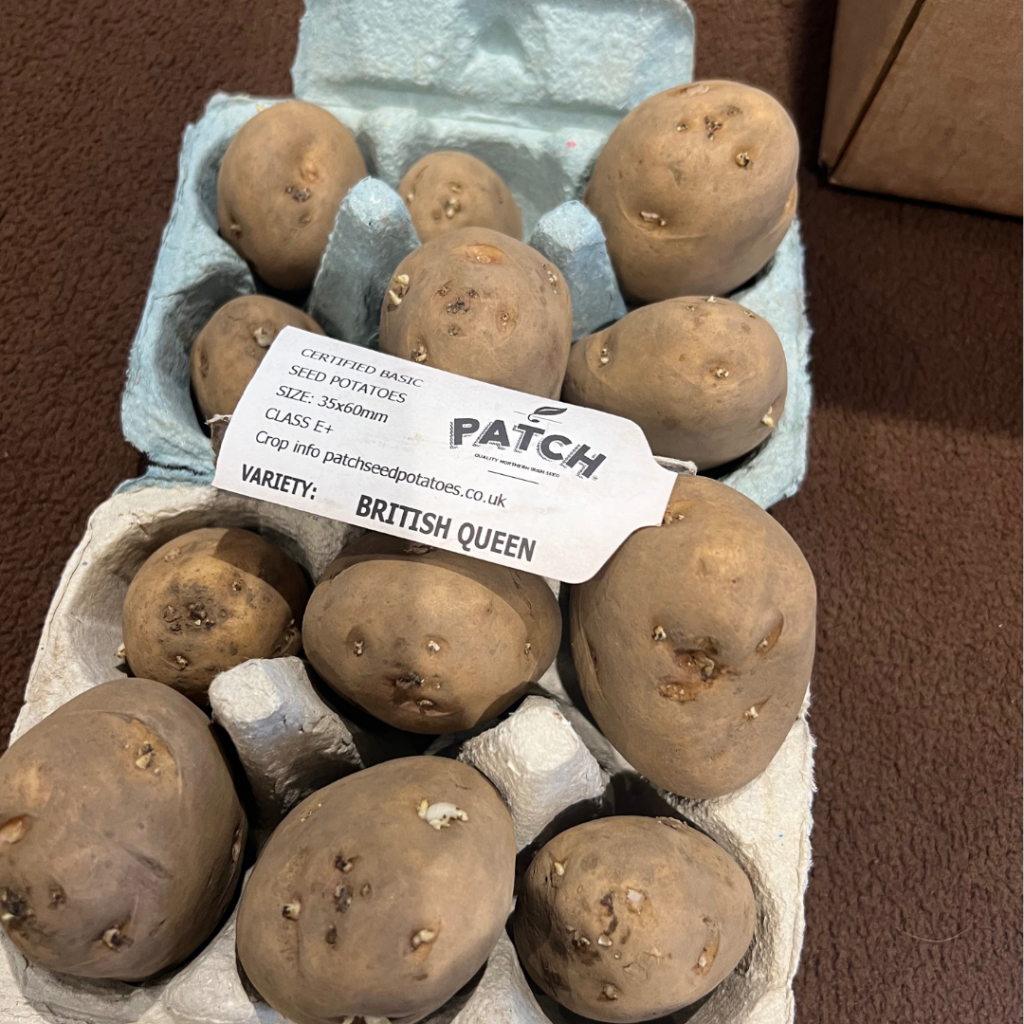
Chitting Potatoes
Chitting potatoes is a simple yet highly effective technique to boost your potato-growing success. By encouraging potatoes to sprout before planting, you give them a head start, resulting in earlier, more vigorous plants. It also helps you identify and remove any unhealthy or damaged tubers, ensuring a higher success rate when planting.
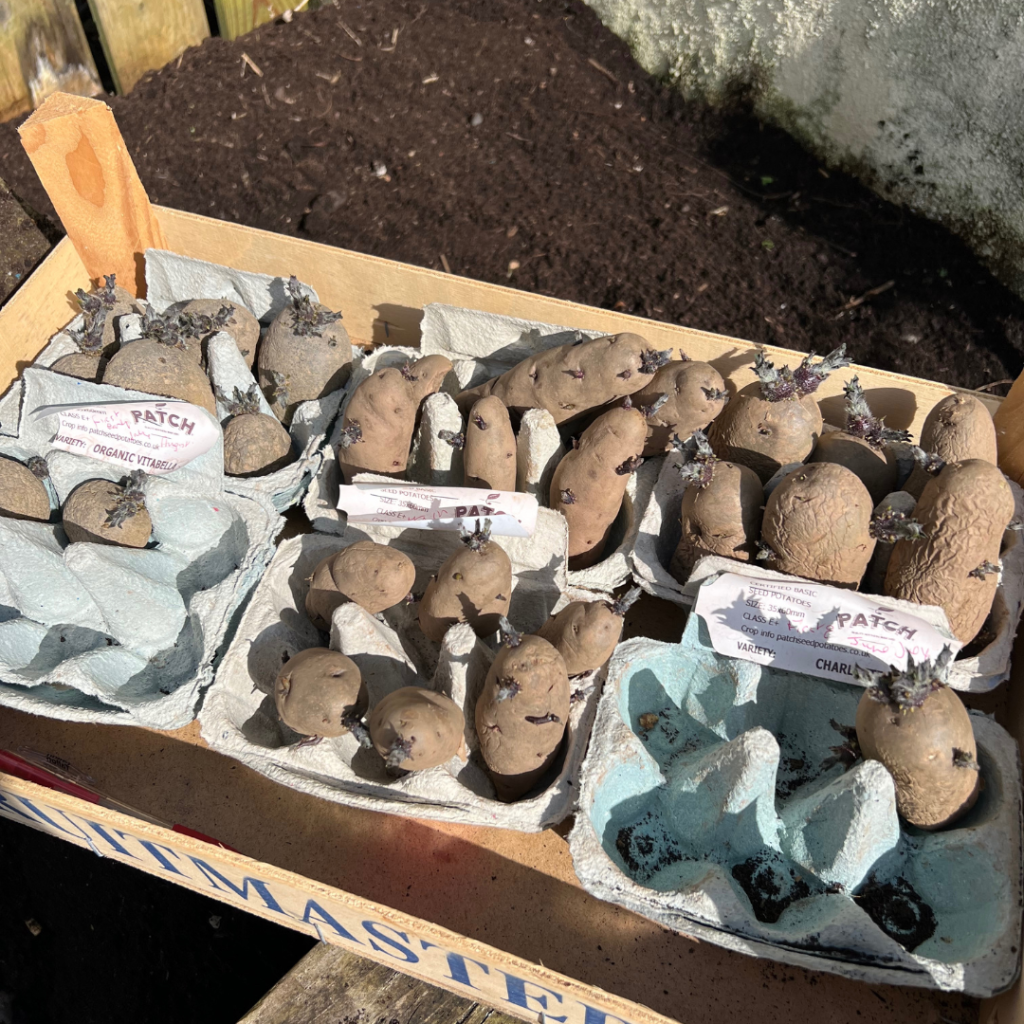
Follow this step-by-step guide to chit your potatoes for the best results:
- Choose Your Seed Potatoes: Select the best quality seed potatoes for chitting. You can find them at your local garden centre or online. If you’re unsure which type to choose, first early potatoes are perfect for an early harvest.
- Prepare a Tray or Carton: Lay your seed potatoes on a tray, egg carton, or shallow box. Make sure the eyes (the small buds) are facing upwards. This encourages the sprouts to grow in the right direction.
- Place in a Cool, Light Spot: Put the tray in a cool, well-lit area (around 7°C to 10°C), such as a windowsill. Avoid direct sunlight as this can cause the potatoes to become too warm and dry out.
- Wait for Sprouts to Appear: In about 4-6 weeks, the potatoes will start to develop short, sturdy sprouts. These should be around 1-2 inches long by the time they’re ready for planting.
- Plant When Ready: Once your seed potatoes have sprouted, they’re ready for planting. Follow planting instructions for your specific variety, generally about 6-8 inches deep in well-prepared soil, with the sprouts facing upwards.
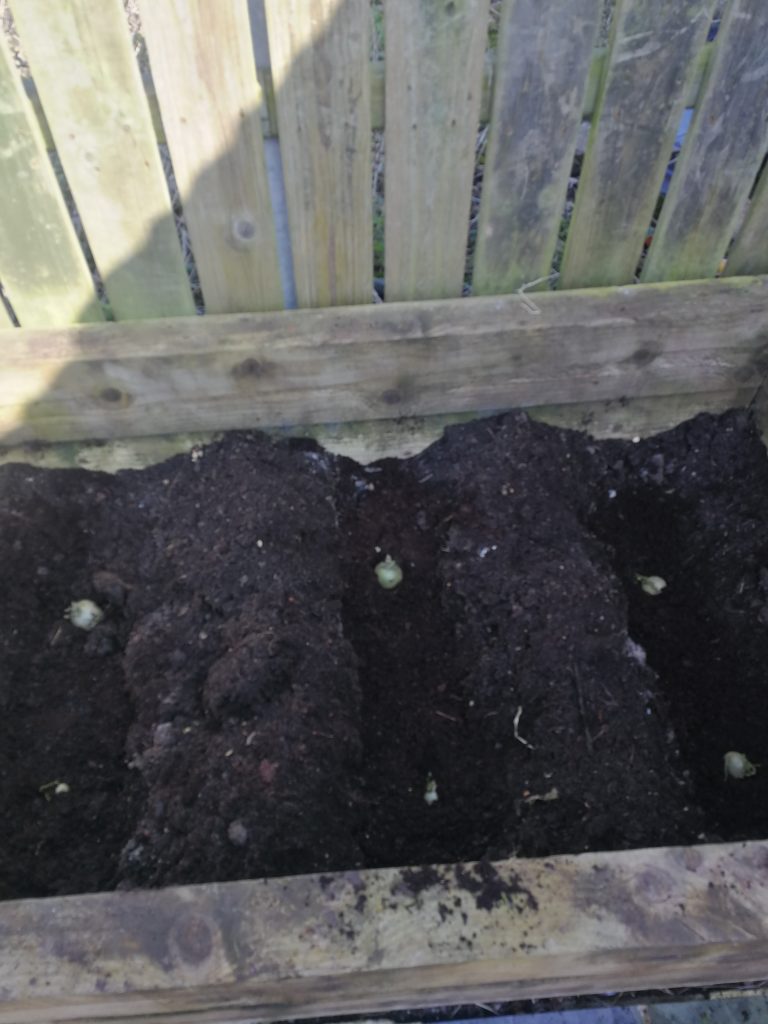
Earthing Up
Earthing up is a crucial step in growing potatoes that helps protect the developing tubers from sunlight and encourages a larger, healthier harvest. As the potato plants grow, their stems will begin to show above the soil. At this point, you’ll need to mound soil around the base of the plants, covering the stems and leaving just the top few leaves exposed. This can be done in stages as the plants grow taller, typically every 10–15cm of growth. The mounded soil provides several benefits: it prevents the potatoes from turning green (which happens when they’re exposed to sunlight) and helps reduce the risk of blight by improving airflow around the plants. It also supports the plants by stabilising them and helps retain moisture in the soil, which is especially important during dry spells.
Earthing up should be done carefully with a spade or hoe, making sure not to damage the plant’s roots or tubers. Continue to mound up soil until the plants are about 30cm tall, and keep doing this until the plants stop growing, your containers or raised beds are full or you begin to see the first signs of flowers.
First Earlies
For first early potatoes, we begin chitting our seed potatoes in late January to early February, allowing them to develop strong sprouts. These potatoes are ready to plant once sprouted, typically around St. Patrick’s Day (17th March), ensuring a rewarding harvest of early potatoes. These potatoes are perfect for enjoying fresh, new potatoes well before the main crop varieties are ready.
Some of the best first early potato varieties to try include:
- ‘Arran Pilot’: Known for its smooth, creamy texture and delicate flavor, perfect for boiling or steaming.
- ‘Rocket’: A fast grower with excellent resistance to potato diseases, making it a reliable choice for gardeners.
- ‘Red Duke of York’: This variety offers vibrant red skin and firm, waxy flesh, perfect for salads or roasts.
With these delicious varieties, you can enjoy the satisfaction of harvesting your first earlies early in the season.
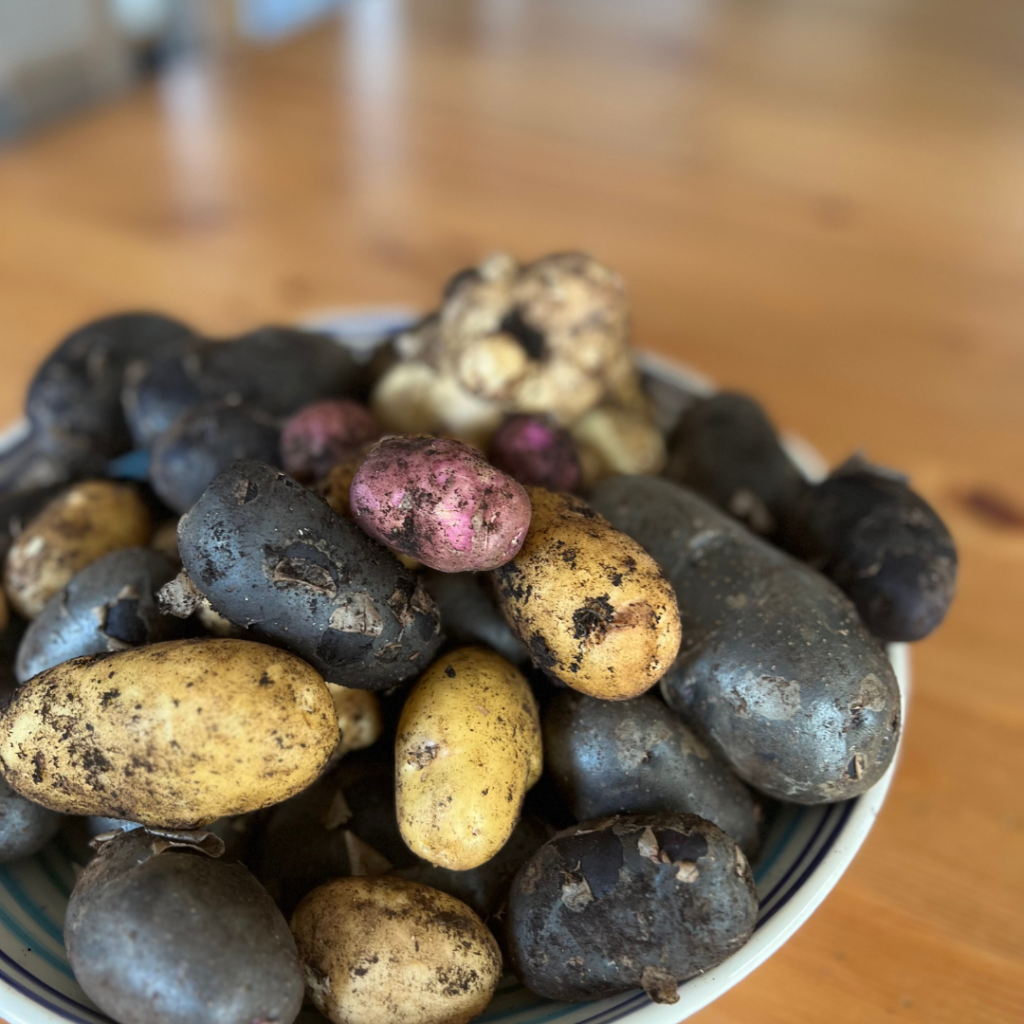
Second Earlies:
Second early potatoes offer the best of both worlds: the early harvest of first earlies combined with the larger yield of maincrop varieties. Start chitting these potatoes around mid to late February, allowing time for strong sprouts to form. Once the frost risk has passed, plant them in fertile soil for a rewarding harvest.
Some top second early varieties include:
- ‘Charlotte’: A firm, waxy potato with great flavor, ideal for salads or boiling.
- ‘Maris Peer’: A versatile potato with good disease resistance, excellent for roasting, mashing, or steaming.
- ‘Kestrel’: Known for high yields and a superb, floury texture, perfect for a variety of dishes.
By selecting a mix of these varieties, you’ll have a flavorful harvest of second early potatoes to enjoy in the summer months.
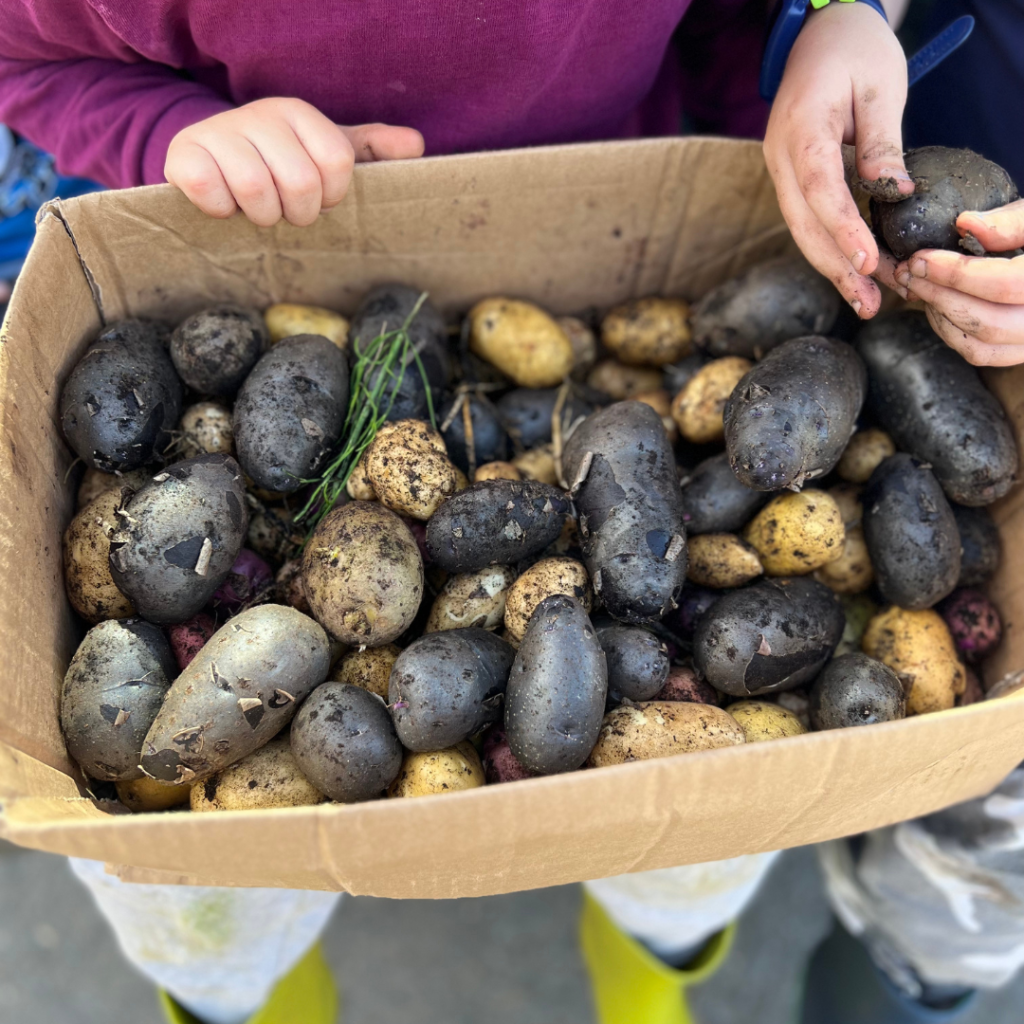
Main Crops:
Main crop potatoes are known for their large size and excellent storage capabilities. While chitting is not as critical for main crops, it can still give them a head start. Begin chitting these potatoes in March, and plant them in late March to early April once the danger of frost has passed. This timing ensures a long growing period and sets the stage for a generous harvest come late summer or early autumn.
Some of the most popular maincrop potato varieties include:
- ‘King Edward’: A classic with a floury texture and great flavor, perfect for roast potatoes or creamy mashed potatoes.
- ‘Maris Piper’: Known for its smooth, white flesh that holds together well for boiling, baking, or frying.
- ‘Purple Majesty’: A unique variety with striking purple skin and a rich, nutty flavor, making it a standout on the plate.
These main crop varieties will provide you with a great harvest, ensuring you have plenty of potatoes to store for the winter months.
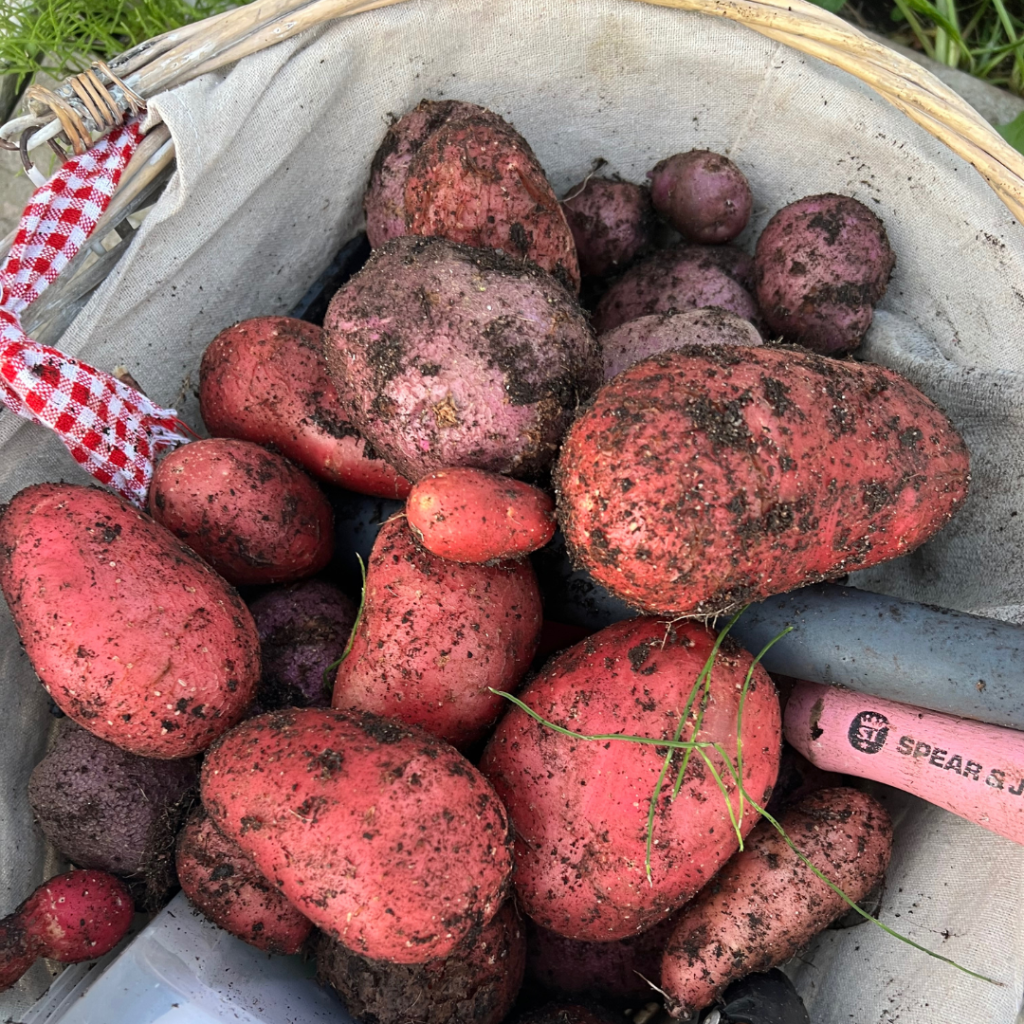
Growing Potatoes for Christmas
While I haven’t grown potatoes specifically for Christmas yet, it’s something I plan to try in 2025. I love the idea of homegrown spuds right in time for Christmas dinner. I am sure with a bit of planning and the right timing, you and I can have our own festive potatoes ready to enjoy this year!
Here’s my plan to grow potatoes for Christmas:
- Choose the Right Variety:
To have potatoes ready for Christmas, you’ll need a variety that matures quickly in cooler temperatures. Second early varieties like Charlotte or Maris Peer are perfect choices since they grow fast, but still produce decent-sized tubers by the time Christmas rolls around. - Planting Time:
For Christmas potatoes, aim to plant your seed potatoes in late summer, around July or August. This will allow enough growing time to have them ready for harvest by early December, just in time for the festive season. - Containers or Raised Beds:
I will be planting in containers and raised beds. Simply fill your containers with nutrient-rich compost and plant your seed potatoes. This method can help keep the soil warmer, encouraging quicker growth. - Care and Harvesting:
As the potatoes grow, don’t forget to earth up the plants to encourage more tubers. When the foliage starts to yellow and die back (usually by early December), it’s time to harvest your Christmas potatoes.
I’m excited to try growing potatoes specifically for Christmas in 2025 and can’t wait to share my experience with you.
Choosing the Best Potatoes
To help you choose the right type of potato for your garden, here’s a quick comparison of First Earlies, Second Earlies, and Main Crops. Each type has its own planting and harvesting times, as well as unique characteristics, so you can decide which one fits best with your growing schedule and culinary needs. Check out the table below to see the key differences and find the perfect potato variety for your garden.
Potato Variety Summary Table
| Type | When to Start Chitting | When to Plant | Harvest Time | Key Features |
|---|---|---|---|---|
| First Earlies | Late January – Early February | Mid March – April | June – July | Fast-growing, small, and great for salads or boiling. |
| Second Earlies | Mid to Late February | April – May | July – August | Slightly larger than first earlies, good for boiling, roasting, and salads. |
| Main Crop | March | Late April – May | August – October | Larger tubers, good for storage, ideal for roasting, mashing, and baking. |
| Christmas Potatoes | Late June | Late July – August | December | Special late planting for a winter harvest. |
Potatoes in Ireland: A Rich History
The potato’s journey to Ireland dates back to the late 16th century, introduced by Sir Walter Raleigh. Quickly becoming a staple crop, the potato offered a reliable food source and helped sustain Ireland’s population, especially during difficult times. Today, the potato remains a dietary cornerstone in Irish cuisine, cherished for its versatility and nutritional value.
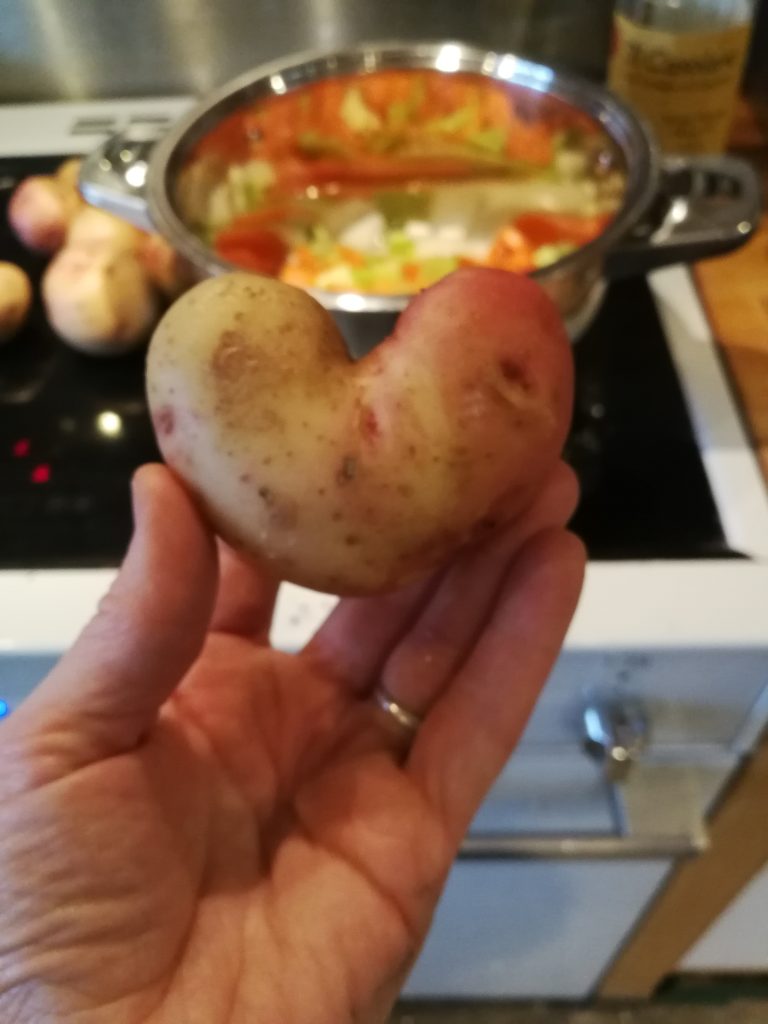
Nutritional Powerhouse:
Potatoes are more than just delicious—they’re a nutritional powerhouse. Packed with vitamin C, potassium, and dietary fiber, they’re an excellent addition to a balanced diet. Potatoes also contribute to a feeling of fullness, aiding digestion and supporting overall health.
When prepared healthily, potatoes can be a nutritious choice for a variety of meals. From boiled potatoes to roasted spuds, they can be enjoyed in many different ways, making them a versatile ingredient for any family meal.
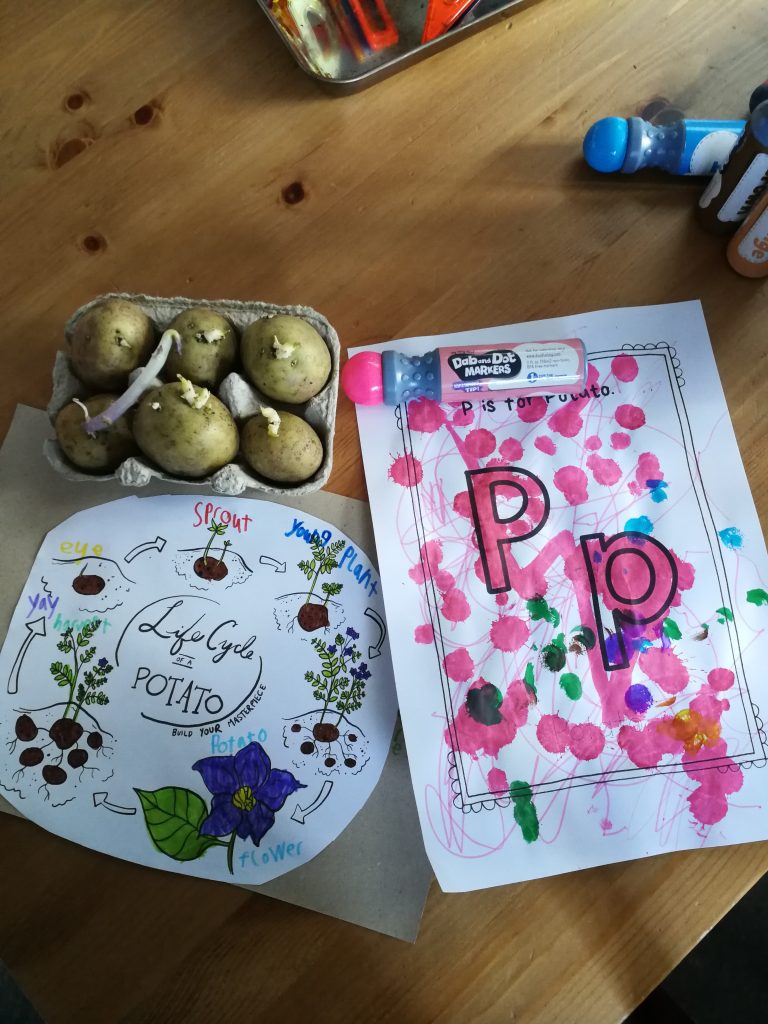
A Hearty Irish Stew Recipe
Now, what better way to enjoy your homegrown potatoes than in a hearty Irish Stew? Here’s my favorite recipe, perfect for using up those first early potatoes once they’re ready:
Ingredients:
- 1 lb (450g) homegrown potatoes (peeled and chopped)
- 1 lb (450g) lamb or beef mince
- 1 large onion, chopped
- 3 carrots, peeled and sliced
- 3 celery stalks, chopped
- 2 cloves garlic, minced
- 4 cups (1 liter) beef broth
- 1-2 tablespoons fresh thyme or parsley
- Celtic Sea Salt and pepper to taste
- 2 tablespoons olive oil or butter
Instructions:
- Heat olive oil in a large pot over medium heat. Brown the meat, then remove and set aside.
- In the same pot, sauté the onions, garlic, carrots, and celery until softened.
- Add the potatoes and return the meat to the pot. Pour in the beef broth and add thyme or parsley. Season with celtic sea salt and pepper.
- Bring to a boil, then reduce the heat to low and simmer for 1-1.5 hours, or until the potatoes are tender and the flavors have melded.
- Serve hot with irish soda bread or wheaten—perfect for soaking up all that delicious broth!

Other Ways to Enjoy Your Potato Harvest
If you’re looking for more ways to use your potatoes, here are a few delicious ideas:
- Homemade Potato Chips – Thinly slice your potatoes, toss them in olive oil and your favorite seasoning, and bake for crispy, homemade chips. Serve with Hummus or a similar dip.
- Potato Salad – Boil your first earlies and mix them with mayo, mustard, and a sprinkle of fresh herbs for a classic summer salad.
- Roast Potatoes – Toss chunks of potatoes with olive oil, garlic, rosemary, and salt, and roast in the oven for the perfect crispy, golden bites.
- Potato Soup – Blend boiled potatoes with stock, onion, garlic, and herbs for a comforting, creamy soup.
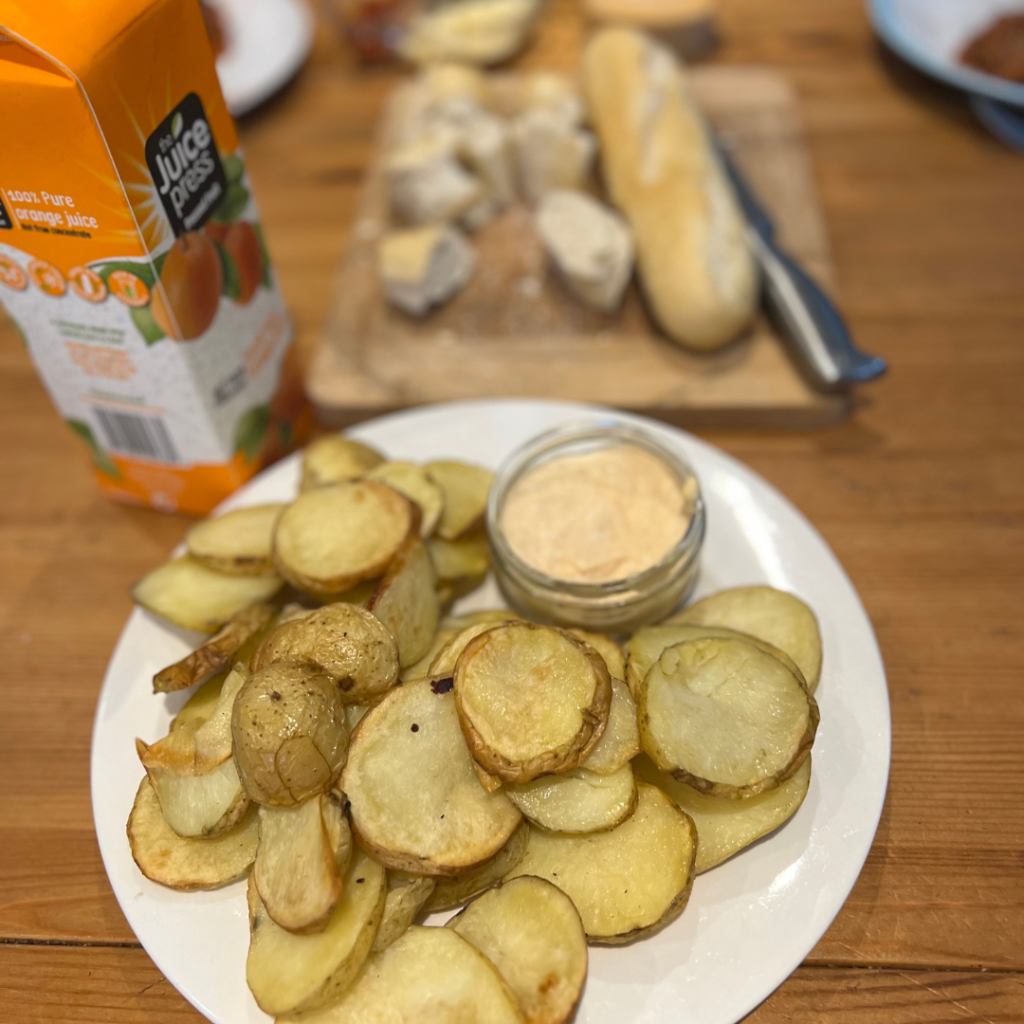
Let Me Know Your Potato Plans!
Will you be growing your own potatoes this year? I’d love to hear about your potato growing plans and what varieties you’re excited to try. Leave me a comment below, and let’s chat all about growing potatoes and making the most of this versatile crop!

I have deliberately grown potatoes one year… but mostly they come up by themselves, and I’m happy to let them! xx
Yes this has happened to me – last year I planned to let one part of my garden rest but I had lots of volunteer potatoes growing instead
One year I planted potatoes in a large black bin and just kept putting soil over the top as the spots grew. We had new potatoes for Christmas! Delicious.
Sounds great I like the idea of Christmas potatoes